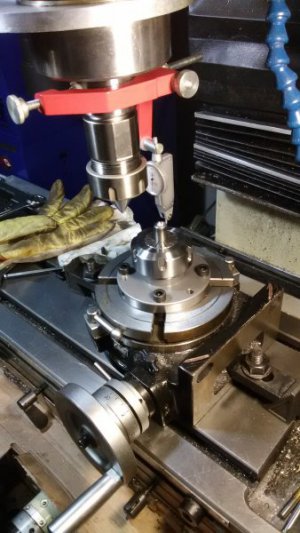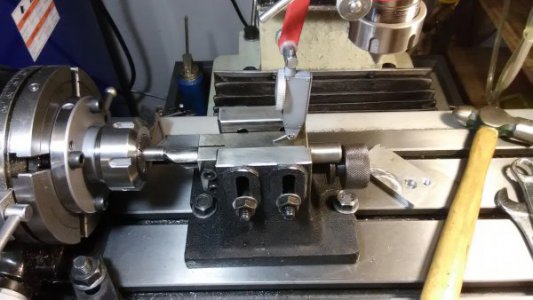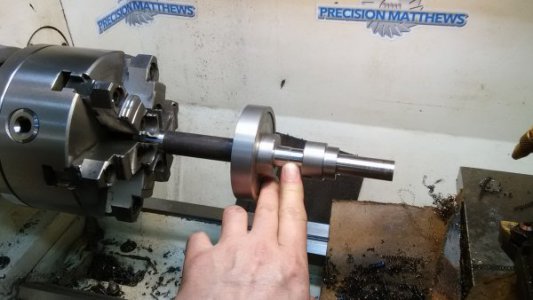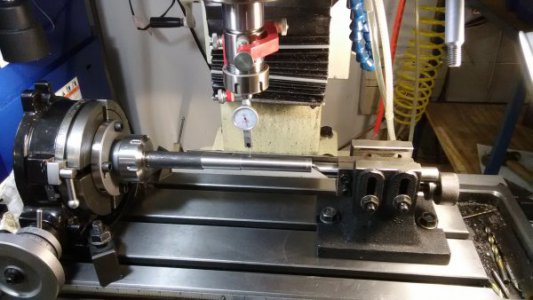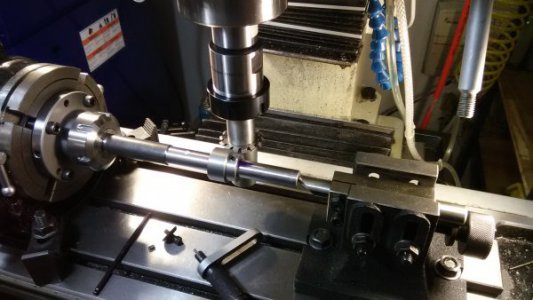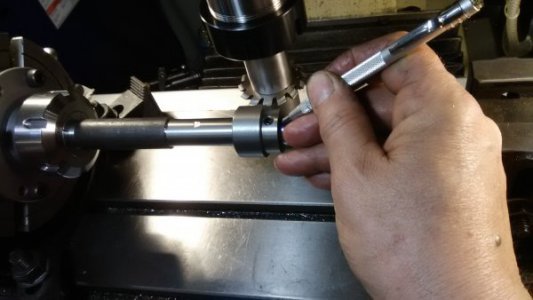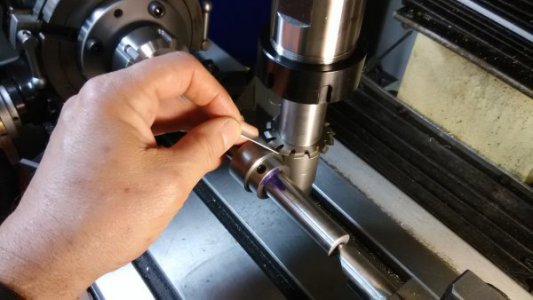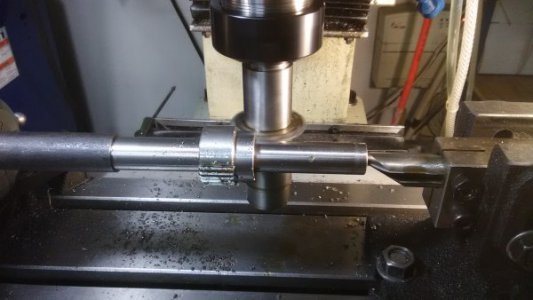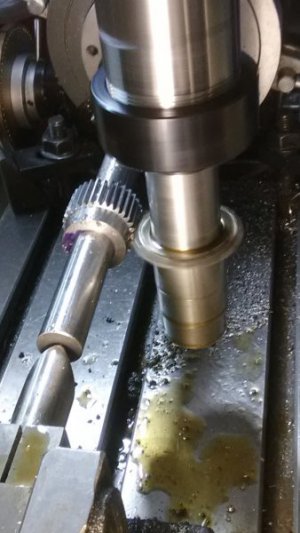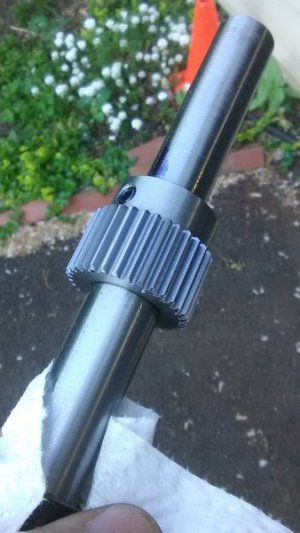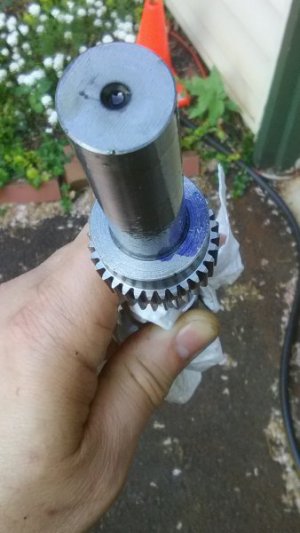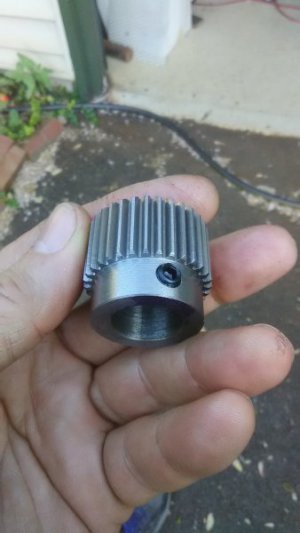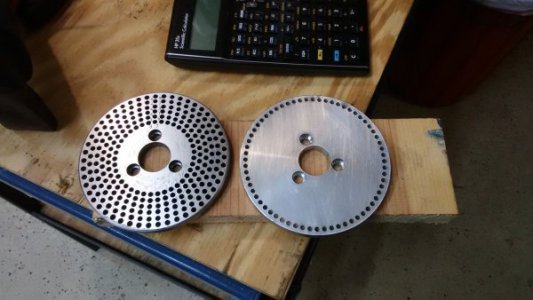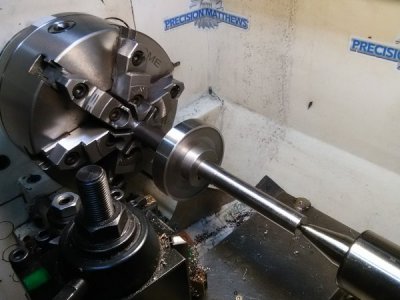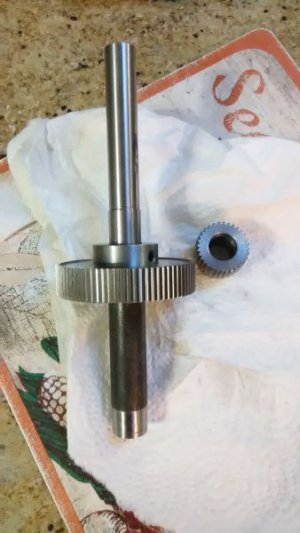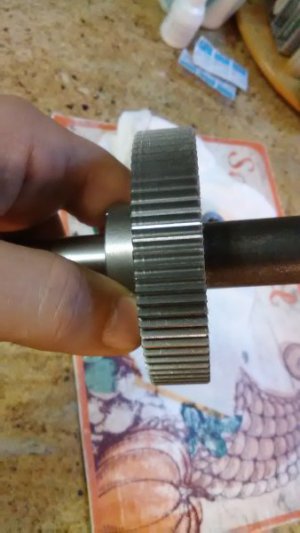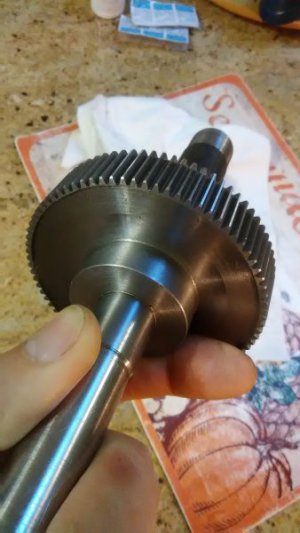- Joined
- Nov 16, 2012
- Messages
- 5,596
Part 1:
I need to cut two gears for a project so, here's a write-up on it. I'll explain what I'm doing and toss in a little "gear talk" along the way. One gear needs to be 32 tooth the other 80 tooth. I'll be using a metric gear cutter but, because I'm more familiar with SAE formulas for gears, I will convert the metric size to SAE and use the SAE formulas. There's nothing wrong with doing this and you still end-up with a proper gear.
Most common gears have a "involute" tooth shape. This means that as two teeth engage each-other, the point along the surface of engagement moves in a smooth, circular-like motion. Furthermore, common gears have a pressure angle of either 14.5 or 20 degrees. The pressure angle is determined by the involute shape of the surface of the tooth. When one gear turns another, two forces are at-play. One force transmits power to the other gear and is a useful force. The other force pushes one gear away from the other along a line through their center-points and does not contribute toward spinning the other gear. The angular sum of those two forces results in the pressure angle. 20 degree PA can transmit more power but, makes more noise when operating. 14.5 degree PA gear will transmit power less efficiently but, operate quietly.
For this project, I want small profile teeth to keep the size of gears small and I have a metric gear cutting set in a small size. Much like the differences between SAE vs metric nuts & bolts, gears are either SAE (Diametral Pitch) or metric (Modulus) based. There are standard formulas for gear cutting. The method of doing the math for SAE vs metric is a little different because SAE gears are measured by teeth per inch and metric uses millimeters per tooth. Fortunately, you can convert the formula techniques because 1 inch is 25.4mm.
Most standard SAE size gears (from small to large) are 24, 22, 20, 18, 16, 14, 12, 10, 8, 6, 4... teeth per inch (TPI). Standard metric (modulus) gears from (small to large) are 1, 1.5, 2, 2.5, 3, 3.5, 4, 4.5, 6... millimeters per tooth.
SAE Diametral Pitch = 25.4 / Metric Modulus. Conversely, Metric Modulus = 25.4 / SAE Diametral Pitch
You cannot intermix SAE and metric gears just as you cannot intermix SAE and metric nuts & bolts. If two gears are to be used together, they must be either the same Diametral Pitch or Modulus.
The smallest cutting set I have is a modulus 1 (metric) size. I much prefer to work with SAE (diametral pitch) formulas so, I simply convert the size from metric (Module) to SAE (Diametral Pitch). SAE Diametral Pitch = 25.4/Modulus and in this case that's simply 25.4/1 = 25.4 If I had a Modulus 2 size profile, Diametral Pitch would be 25.4/2. etc...
EDIT FOLLOWS:
When the diametral pitch is 25.4, that means for every 1 inch ofcircular distance around diameter across a shaft, you will have 25.4 teeth. So, 25.4 teeth packed into 1 inch of space means the teeth are pretty small. If I were using SAE cutters, the next closest standard size to 25.4 would be a 26 DP gear; meaning, for every 1 inch of circular linear distance, there would be 26 teeth. They look similar but will destroy each-other if used together.
In part 2, we'll talk about how to calculate stock sizes and cutting depths...
Part 3 will talk about how to use the correct gear within a set of gears.
Part 4 will be step-by-step instructions on fixture setup and actual gear cutting.
Stay tuned. Here's a preview of the grande finale...
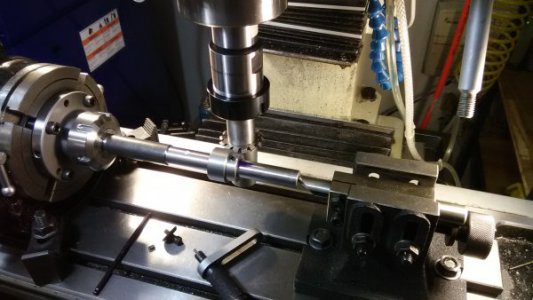
Ray
EDIT: I corrected a misstatement diametral distance after reading brino's question. -My bad.
I need to cut two gears for a project so, here's a write-up on it. I'll explain what I'm doing and toss in a little "gear talk" along the way. One gear needs to be 32 tooth the other 80 tooth. I'll be using a metric gear cutter but, because I'm more familiar with SAE formulas for gears, I will convert the metric size to SAE and use the SAE formulas. There's nothing wrong with doing this and you still end-up with a proper gear.
Most common gears have a "involute" tooth shape. This means that as two teeth engage each-other, the point along the surface of engagement moves in a smooth, circular-like motion. Furthermore, common gears have a pressure angle of either 14.5 or 20 degrees. The pressure angle is determined by the involute shape of the surface of the tooth. When one gear turns another, two forces are at-play. One force transmits power to the other gear and is a useful force. The other force pushes one gear away from the other along a line through their center-points and does not contribute toward spinning the other gear. The angular sum of those two forces results in the pressure angle. 20 degree PA can transmit more power but, makes more noise when operating. 14.5 degree PA gear will transmit power less efficiently but, operate quietly.
For this project, I want small profile teeth to keep the size of gears small and I have a metric gear cutting set in a small size. Much like the differences between SAE vs metric nuts & bolts, gears are either SAE (Diametral Pitch) or metric (Modulus) based. There are standard formulas for gear cutting. The method of doing the math for SAE vs metric is a little different because SAE gears are measured by teeth per inch and metric uses millimeters per tooth. Fortunately, you can convert the formula techniques because 1 inch is 25.4mm.
Most standard SAE size gears (from small to large) are 24, 22, 20, 18, 16, 14, 12, 10, 8, 6, 4... teeth per inch (TPI). Standard metric (modulus) gears from (small to large) are 1, 1.5, 2, 2.5, 3, 3.5, 4, 4.5, 6... millimeters per tooth.
SAE Diametral Pitch = 25.4 / Metric Modulus. Conversely, Metric Modulus = 25.4 / SAE Diametral Pitch
You cannot intermix SAE and metric gears just as you cannot intermix SAE and metric nuts & bolts. If two gears are to be used together, they must be either the same Diametral Pitch or Modulus.
The smallest cutting set I have is a modulus 1 (metric) size. I much prefer to work with SAE (diametral pitch) formulas so, I simply convert the size from metric (Module) to SAE (Diametral Pitch). SAE Diametral Pitch = 25.4/Modulus and in this case that's simply 25.4/1 = 25.4 If I had a Modulus 2 size profile, Diametral Pitch would be 25.4/2. etc...
EDIT FOLLOWS:
When the diametral pitch is 25.4, that means for every 1 inch of
In part 2, we'll talk about how to calculate stock sizes and cutting depths...
Part 3 will talk about how to use the correct gear within a set of gears.
Part 4 will be step-by-step instructions on fixture setup and actual gear cutting.
Stay tuned. Here's a preview of the grande finale...

Ray
EDIT: I corrected a misstatement diametral distance after reading brino's question. -My bad.
Last edited:

